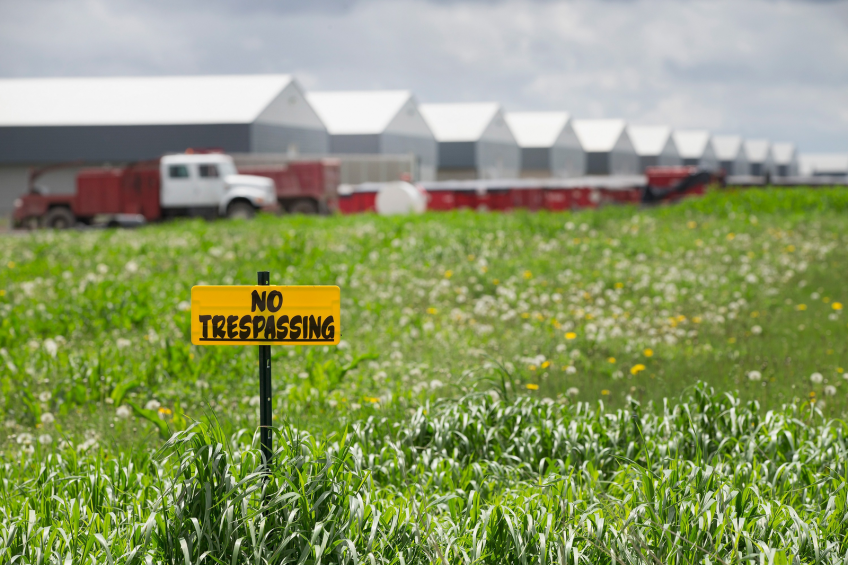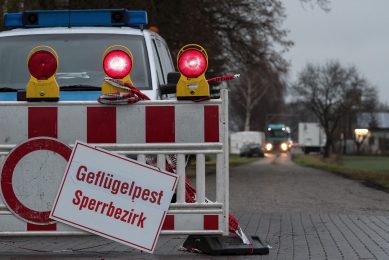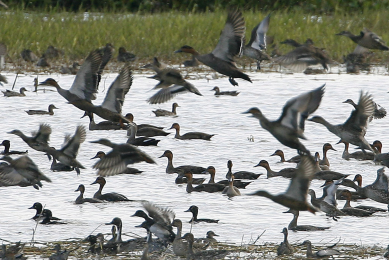US in state of emergency over HPAI

As large parts of the world worry about sporadic outbreaks of highly pathogenic avian influenza, the US is hit hard. States Minnesota, Iowa and Wisconsin declared a state of emergency. On more than 100 farms the virus was detected and millions of birds had to be destroyed. HPAI is in the migratory routes of wild birds now, posing new challenges and demanding new approaches.
During the last quarter of 2014 poultry producers in the EU were faced with the emergence of H5N8 strain avian influenza which proved highly pathogenic to chickens and turkeys. Outbreaks affecting flocks in the Netherlands, the UK, Germany and Russia were controlled by depletion followed by decontamination. In accordance with procedures mandated by the OIE, designated control zones subjected to restrictions on movement of poultry and products were imposed and surveillance was implemented. In December 2014 Canada recorded a series of cases in small flocks in the Southern Fraser Valley of British Columbia. Within a short time outbreaks were recorded in the Pacific Northwest of the US in the states of Oregon, Washington and California. Outbreaks in Asia, the EU and North American continued from January through March 2015. Infection was recorded in Japan, Taiwan, and once again in the EU, involving Hungary, Germany and the Netherlands. Fortunately widespread lateral infection was not a feature of 2014 outbreaks compared to previous episodes in Italy in 1999, in Asian nations from 2000 onwards and in the Netherlands during 2003.
Biology of avian influenza virus
Avian influenza viruses are classified by their exterior glycoproteins comprising hemagglutinin (H) proteins with 16 distinct recognised subtypes designated H1 through H16. The neuraminidase (N) proteins are identified as N1 through N9. Within the subtypes there are a variety of strains. It is generally accepted that the H5N8 viruses isolated in the EU originated in Asia and were disseminated among co-migrating bird species along the Pacific flyway. During the 2014 migration, intermingling and cohabitation of different species of waterfowl resulted in reassortants containing Asian-origin H5 genes and N genes from low-pathogenic avian influenza from migratory waterfowl.
Studies conducted by virologists at the USDA-ARS Southeastern Poultry Research Laboratory and the National Veterinary Diagnostic Laboratory have identified an H5N2 virus which was present in the Fraser Valley British Columbia outbreaks in addition to a new strain of H5N1 virus. This differs from the strain which emerged originally in China and impacted Thailand and neighbouring nations from 2003 onwards. This H5N1 strain was responsible for extensive losses in poultry and in a few incident cases among humans with close contact with sick poultry and their viscera.
In the central flyways
Currently a specific H5N2 virus is the major strain present in the Mississippi and Central flyways of the US. This virus does not appear to have any public health implications and details relating to personal precautions to prevent infection are available from the Centers for Disease Control and Prevention www.cdc.gov.
Further details on the origin and pathogenicity of the US H5N2 HPAI virus were recently released by scientists working at the Southeast Poultry Research Laboratory in Athens GA. This virus contains genetic material from strains emanating in China in 1996. The virus includes three variants all of which were derived by reassortment. The virus is pathogenic to chickens, quails and turkeys but requires a higher quantum of infection compared to previously evaluated HPAI viruses. The H5N2 strain is highly adapted to waterfowl and infection and inter-bird transmission among mallards occurs readily although the virus is innocuous in this species and for most other waterfowl.
Advances in molecular biology have expedited the diagnosis of avian influenza. Field deployment of antigen capture immunoassay kits extends the capabilities of field investigators. The application of real time-polymerase chain reaction assay (rRT-PCR) can detect the presence of avian influenza viral RNA within hours of submission of tracheal or cloacal swabs to a suitably laboratory. Gene sequencing has allowed molecular epidemiologists to trace the origin of viruses. It is possible to monitor shifts occurring as a result of the interchange of genetic material among strains to produce new reassortant viruses with altered pathogenicity and host specificity.
The recent US outbreaks
It became evident from epidemiologic investigations in the EU and North America that avian influenza infection is transmitted from migratory waterfowl which serve as unaffected reservoirs. The 2014 outbreaks in the EU were probably associated with migration southward to winter breeding grounds. The subsequent cases occurring in March and April 2015 in the US are attributed to H5N2 virus shed by waterfowl moving northward along the Central and Mississippi flyways.
The situation with regard to outbreaks in the US is updated each week by the United States Department of Agriculture – Animal Plant Health Inspection Service. Until April 2015 there have been ten outbreaks, most of them in turkey grow-out or breeder operations, after that the situation exploded and hit major egg producing facilities. In total more than 100 farms are affected, 16 million birds have already been culled. Generally individual affected flocks are depopulated by joint action by Federal and state control teams within two to three days of confirming the diagnosis. Surveillance of free-living birds has yielded H5N8, H5N2 and H5N1 reassortants from the Pacific, Central and Mississippi flyways. States involved include Washington (16 detections), Oregon (17 detections), California (3 detections), Idaho (7 detections), Nevada (1 detection), Utah (1 detection), and Wyoming (1 detection). The frequency of isolation is effectively a function of surveillance intensity. States with commercial outbreaks involving turkeys include Arkansas, Missouri, Minnesota and California.
The state quarantines every farm or any premises with a confirmed infection pending depletion. An area 3 km in radius from the index farm is designated the “Infected Zone” requiring an embargo on movement of live birds until the status of all flocks is ascertained by surveillance. The next 7 km extending outward from the central “Infected Zone” comprises the “Buffer Zone” and collectively the entire zone 10 km in diameter is the “Control Area”. Limits on movement are imposed and surveillance is carried out according to a structured programme. Control is extended to a further concentric 10 km area to create a 20 km area to allow surveillance and monitoring of all commercial and backyard units.
Millions of chickens culled to prevent spread of the disease.
Economic significance of 2015 HPAI infections
Emergence of highly pathogenic avian influenza has profound implications for the US poultry industry. The extent of projected 2015 production in the broiler, turkey and egg sectors is indicated in Table 1 confirming the magnitude of flocks at potential risk of a extensive infection.
The most important consequence of isolating either an H5 or an H7 avian influenza virus is the need to report the location and occurrence to the OIE and also to trading partners with whom the US has bilateral agreements. In some cases even the occurrence of an H5 avian influenza virus from a backyard flock of 50 hens or ducks in a region remote from an area of commercial poultry production can result in an unjustified national trade embargo.
Exports of broiler meat in the US in 2014 attained 3.3 million metric tonnes valued at €7.5 billion. As a result of the series of reports submitted to the OIE, 11 nations have suspended imports of all US-origin poultry and poultry products. These include fertile eggs and day-old chicks, thereby severely impacting primary breeders who have had to source shipments from breeding operations in the EU and Asia to supply export orders. Policies which dictate that an entire nation is not eligible to export live poultry or hatching eggs if any avian influenza has been diagnosed within the past 12 months.
Exports downgraded
Approximately 35 nations including many within the EU have adopted regionalisation in their approach to imposing embargos. Clearly it is unjustified to ban importation from broiler producers located in the southeastern United States when HPAI has been controlled by quarantine and flock depletion in states 3,000 km distant. In the March 16th projection by the USDA-Economic Research Service, broiler exports were downgraded in 2015 to 3.22 million metric tonnes or 17.5% of production compared to 2014 with a total production of 17.5 million metric tonnes and exports of 3.32 million metric tonnes or 19.0% of production. In February USDA reported a 14% decline in both volume and value of broiler parts comprising 94% of broiler exports compared to February 2014, attributed mainly due to influenza embargos.
At the field level, the Federal government indemnifies producers for birds depleted in the course of a control program. Farmers are however not reimbursed for birds that may die of influenza. Concern over a large-scale outbreak of HPAI has prompted a bipartisan amendment to the fiscal 2016 Senate Budget Resolution to support vaccine development, research on migratory patterns of waterfowl, surveillance of migratory birds and modelling to predict virus spread. The Federal authorities, supported by their state counterparts are incurring costs in control and eradication. It is possible that in the event of an extensive outbreak, supplementary funds may be required to maintain a programme of depletion with compensation, a key legal requirement for eradication.
Apart from the public and production sectors, consumers invariably pay more for poultry meat and eggs in the event of a major outbreak of poultry disease. This was the case in the northeast metropolitan markets when eggs doubled in price following the emergence of H5N2 HPAI in Pennsylvania and contiguous states in November 1983. It was estimated that the Federal government spent €175 million on control (using 1984 values), producers lost €40 million in direct costs but consumers paid over €560 million more for eggs and meat over the duration of the outbreak which extended over two months.
Prevention
Concern over the outbreaks of H5N2 influenza in the states at risk under the Central and Mississippi flyways has resulted in a marked reappraisal of biosecurity. Precautions in the US commercial sector are generally less effective than in the EU or in nations with endemic Newcastle disease and avian influenza. The major deficiencies lie in structural biosecurity including the absence of hardened roads, fencing, shower and change room facilities and installations to decontaminate vehicles. Operational biosecurity involving day-to-day activities is also lacking since adequacy of precautions to prevent disease depends on capital investment in structural biosecurity.
Vehicle desinfection at road blocks.
During the past few weeks, no one associated with commercial poultry should have had any contact with wild birds or backyard farms. Protective clothing is now used although there is an ongoing shortage of disposable coveralls and footwear. This is due to the demand following outbreaks of Ebola disease in West Africa and a concurrent stockpiling and upgrading of personal biosecurity in US medical facilities.
Inherent vulnerabilities to highly contagious diseases potentially affecting the US poultry industry include concentration of broiler, turkey and egg production complexes in close proximity. This situation has arisen over decades due to specific areas within states offering advantages such as a favourable climate, cost of grains, transport infrastructure, non-rigorous environmental restrictions coupled with the availability and cost of power, water and labour. Broiler production is concentrated on the Eastern Shore of the Delmarva Peninsula (Maryland, Virginia and Delaware), Northwest Arkansas, and central Georgia. Turkey production is highly concentrated in eastern North Carolina and in Central and Western Minnesota and contiguous counties in North and South Dakota. There are large numbers of egg production units in three adjacent counties in northwest Ohio and in Indiana.
Secure egg supply programmes
The need to be able to move eggs at daily intervals from unaffected production complexes with over 1 million hens in a control area is an obvious issue in the US. Refrigerated storage capacity is limited and these complexes cannot function for more than a few days in the event of a complete ban on the movement of products including washed and packed shell eggs and egg liquid in sealed trailers. Accordingly individual states have developed Secure Egg Supply Programs to permit movement of eggs from unaffected farms in a quarantined area. Criteria for participation in the programme include; high levels of structural and operational biosecurity for the farm, traceability including GPS co-ordinates for the complex, training of personnel on the farm, demonstrating freedom from infection prior to movement of product applying rRT-PCR assay on routine mortality and reviewing production records on a daily basis. Similar secure supply programmes have been developed and tested for broilers and turkeys in areas of high density of poultry.
Detection and eradication
Given the fact that migratory waterfowl are the reservoirs of infection, and the protection of commercial production units appears to be effective, Federal authorities, having statutory jurisdiction over HPAI and other exotic diseases will continue to follow current policy. This is predicated on early detection and rapid depopulation to eradicate foci of infection. This is accompanied by local and regional quarantine with surveillance in order to limit dissemination of infection. The use of vaccines in the US is not contemplated. As the disease has entered the commercial population and resulted in extensive losses, as in Mexico in 2003 and then again in 2012, vaccination might become a consideration. To this end, recombinant HVT products are available and could be administered at hatcheries with supplemental enhancement of immunity using inactivated oil emulsion vaccines.
Inherent in its mission to develop new technology for the diagnosis and control of avian diseases the USDA-ARS Southeast Poultry Research Laboratory is developing a vaccine effective against H5 strains of avian influenza. Vaccines might be considered if eradication is either technically impossible or financially infeasible. The application of an H5 or H7 influenza vaccine would have profound trade implications for the US. Absent the use of a DIVA approach, vaccinated birds would have antibodies which would compromise a diagnosis based on serology. In past decades this would be considered a serious disadvantage in detection and control. With modern antigen-capture and rRT-PCR technology a diagnosis of HPAI does not rely on either an agar- gel plate assay or serum-virus neutralisation.











